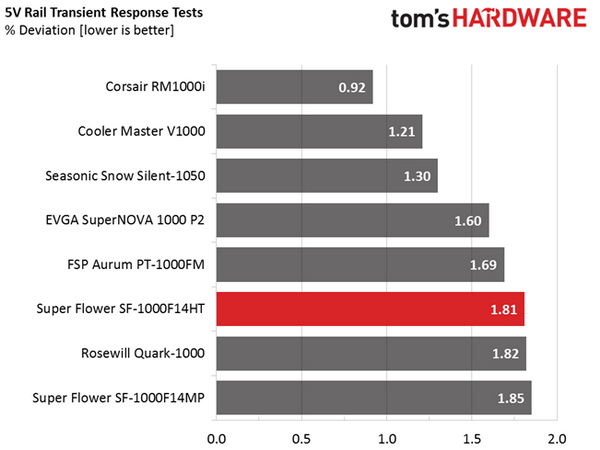Super Flower Leadex Titanium 1000W PSU Review
Super Flower was one of the first companies to release an 80 Plus Titanium-rated PSU. Following the ultra-high-capacity SF-1600F14H unit, the company released two more Titanium PSUs, one of which we're evaluating today.
Why you can trust Tom's Hardware
Transient Response Tests
Advanced Transient Response Tests
For details on our transient response testing, please click here.
In these tests, we monitored the response of the PSU in two different scenarios. First, a transient load (10A at +12V, 5A at 5V, 5A at 3.3V and 0.5A at 5VSB) was applied to the PSU for 200ms while the PSU was working at 20 percent load. In the second scenario, the PSU was hit by the same transient load while operating at 50 percent load. In both tests, we used our oscilloscope to measure the voltage drops caused by the transient load. The voltages should have remained within the ATX specification's regulation limits.
These tests are crucial because they simulate the transient loads a PSU is likely to handle (such as booting a RAID array or an instant 100 percent load of CPU/GPUs). We call these tests "Advanced Transient Response Tests," and they are designed to be very tough to master, especially for a PSU with a capacity of less than 500W.
Advanced Transient Response at 20 Percent
| Voltage | Before | After | Change | Pass/Fail |
|---|---|---|---|---|
| 12V | 12.154V | 12.107V | 0.39% | Pass |
| 5V | 5.027V | 4.932V | 1.89% | Pass |
| 3.3V | 3.304V | 3.186V | 3.57% | Pass |
| 5VSB | 5.048V | 5.013V | 0.69% | Pass |
Advanced Transient Response at 50 Percent
| Voltage | Before | After | Change | Pass/Fail |
|---|---|---|---|---|
| 12V | 12.133V | 12.088V | 0.37% | Pass |
| 5V | 5.013V | 4.927V | 1.72% | Pass |
| 3.3V | 3.296V | 3.183V | 3.43% | Pass |
| 5VSB | 5.029V | 4.993V | 0.72% | Pass |





Super Flower's Leadex platforms repeatedly prove that they can handle transient loads well, especially on the +12V rail. This PSU is another fine example of this; as you can see, the +12V rail kept its deviation within 0.4 percent in both tests. The 5V and 5VSB rails also performed quite well. Only the 3.3V rail fails to impress, as its voltage dropped below 3.2V in both cases.
Here are the oscilloscope screenshots we took during Advanced Transient Response Testing:
Transient Response At 20 Percent Load




Transient Response At 50 Percent Load




Turn-On Transient Tests
In the next set of tests, we measured the response of the PSU in simpler transient load scenarios -- during the PSU's power-on phase.
For the first measurement, we turned off the PSU, dialed in the maximum current the 5VSB could output and switched on the PSU. In the second test, we dialed the maximum load the +12V could handle and started the PSU while it was in standby mode. In the last test, while the PSU was completely switched off (we cut off the power or switched off the PSU by flipping its on/off switch), we dialed the maximum load the +12V rail could handle before switching on the PSU from the loader and restoring the power. The ATX specification states that recorded spikes on all rails should not exceed 10 percent of their nominal values (+10 percent for 12V is 13.2V, and 5.5V for 5V).
Get Tom's Hardware's best news and in-depth reviews, straight to your inbox.



A small spike on the 5VSB rail is nothing to worry about. The +12V rail demonstrated an almost perfect waveform in both tests. In general, the performance of the SF-1000F14HT PSU is great. If that spike hadn't shown up at 5VSB, it would have been flawless.
Current page: Transient Response Tests
Prev Page Cross-Load Tests And Infrared Images Next Page Ripple Measurements
Aris Mpitziopoulos is a contributing editor at Tom's Hardware, covering PSUs.
-
AnimeMania Are modular cables interchangeable between the different power supply vendors or will this happen in the future.Reply -
blazorthon ReplyAre modular cables interchangeable between the different power supply vendors or will this happen in the future.
Some might be, but generally, don't expect interchangeable cables. There are many different implementations for the connectors for one reason or another. -
Aris_Mp ReplyAre modular cables interchangeable between the different power supply vendors or will this happen in the future.
It highly recommended to assume that they are not, even when the PSU is made by the same manufacturer.
-
Aris_Mp ReplySo, ah, what did you use as a price?
We used the price sold in EU stores, excluding the VAT of course. -
babernet_1 Reply17269051 said:So, ah, what did you use as a price?
We used the price sold in EU stores, excluding the VAT of course.
Which is? I looked and saw a price of 200 euro. That's about $220. Does it include VAT? -
babernet_1 Reply17273936 said:yes, in EU most stores include VAT in their prices.
My gosh! I just want to know in dollars what your estimated price was!
:??: -
Andi lim Using a bunch of KRG series capacitor for extra suppress ripple in Titanium PSU ?Reply
The Analogy : you want to build a super car, lets say Nissan GTR, but at the end you decide to use some cheap parts from Datsun on to your car, hahahaha.
The Question is, How long this PSU will stay in titanium level efficiency ?
Let's say after a year usage, the standard and cheap KRG capacitor will slowly increace the ESR, leak current dan temperature. at that time, this PSU efficient will go to platinum level or below ? Only time will tell.